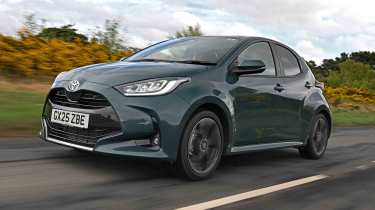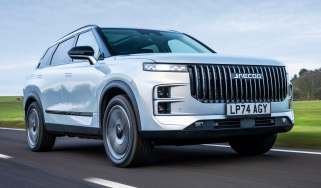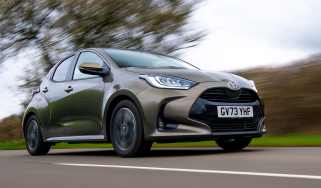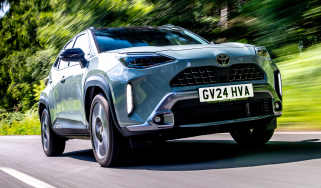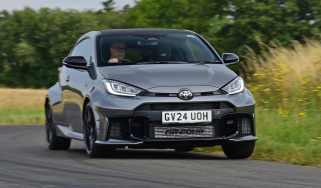Toyota Yaris review
An efficient hybrid powertrain and plenty of standard kit make the Toyota Yaris a key contender in the supermini segment

Our opinion on the Toyota Yaris
The latest Toyota Yaris supermini is a fine choice in our view if you’re looking for something with good fuel economy, plenty of kit thrown in as standard and that’s very easy to drive around town.
The fourth-generation Yaris is a great performer in the urban environment, and it can cope with a bit of B-road and motorway action on the odd occasion. However, it isn’t the cheapest hybrid around, there’s limited room for people in the back, and a small boot could limit its appeal for a family. Its dull interior could also prove to be a stumbling block for some.
| Key specs | |
| Fuel type | Hybrid |
| Body style | Supermini |
| Powertrain | 1.5-litre, 3cyl petrol plus 1x e-motor, front-wheel drive |
| Safety | 5-star (Euro NCAP, 2020) |
| Warranty | 3yrs/60,000 miles (up to 10yrs/100,000 miles with routine servicing) |
About the Toyota Yaris
Even without considering the marvellous GR Yaris hot hatch that holds so much appeal for keen drivers, the regular version of Toyota’s Yaris supermini still deserves to be lauded as the best version to date. As a pioneer of hybrid technology, the Japanese brand has concentrated on delivering an increasingly green range. To this end, while most car makers continue to offer petrol and diesel vehicles in their line-ups, the Yaris features a single petrol-hybrid powertrain.
Traditional rivals such as the Vauxhall Corsa, Peugeot 208, Hyundai i20 and Volkswagen Polo provide myriad engine and trim combinations, but anyone considering the Yaris might also be drawn specifically towards the Renault Clio E-Tech or Honda Jazz, which feature similar fuel-sipping hybrid set-ups. They may even consider the Mazda 2 Hybrid, which would be ironic, because it’s essentially a Yaris, just with Mazda badging.
In an ultra-competitive supermini market, the five-door Yaris (the winner of our 2022 Affordable Hybrid Car of the Year award) keeps things simple. The engine range is based around a three-cylinder, 1.5-litre petrol hybrid delivering either 114bhp or 128bhp. Considering that we’ve always found the 114bhp model to provide more than enough power to make it a capable performer around town, we think the latter (which is only available in pricier trims) will only really be necessary if you do most of your driving on faster roads.
Used - available now

2016 Toyota
Yaris
23,898 milesAutomaticPetrol1.3L
Cash £8,500
2025 Toyota
Yaris
75,903 milesAutomaticPetrol1.5L
Cash £11,500
2020 Toyota
Yaris
39,143 milesAutomaticPetrol1.5L
Cash £10,900
2020 Toyota
Yaris
55,778 milesManualPetrol1.5L
Cash £8,000Toyota claims its latest hybrid system allows you to spend more of your time running around on electric power on regular urban journeys than its predecessor, and even has a dedicated EV-only mode to favour it over the petrol engine. However, with only 0.7kWh of battery capacity, don’t expect it to go very far, or all that fast, on volts alone.
The dimensions of this Yaris have shrunk compared to the previous model, with a slightly reduced overall length and a lower roofline than before. The effect is a sporty, more muscular look, with the metallic and pearlescent bi-tone paint finishes particularly striking.
Standard equipment for the Yaris is comprehensive, with the entry Icon trim including 16-inch alloy wheels, automatic headlights and wipers, adaptive cruise control, air-con, a 9.0-inch infotainment touchscreen and Android Auto and Apple CarPlay smartphone connectivity. Mid-spec Design adds extra kit such as LED headlights, privacy glass and the ability to add the optional safety pack that Excel trim comes with for a reasonable £850.
Stepping up to the Excel trim gets you goodies such as wireless phone charging, front and rear parking sensors, a 12.3-inch digital instrument cluster, blindspot monitoring and satellite navigation with full wireless smartphone integration. The GR Sport, despite costing more than an Excel model, actually offers similar equipment to the Design trim, just with sportier styling both inside and out.
Starting from just over £23,000 at the time of writing, the Yaris is a little more expensive than some of its combustion-engined rivals. However, our preferred Design trim sits between the electrified Renault Clio E-Tech and the pricier Honda Jazz in terms of cost, coming in at around £24,500. You’ll need to stump up just over £28,000 in order to get the more powerful 128bhp version, but your consolation is that it comes in lavishly equipped Excel trim. The GR Sport rounds out the range by coming in at a rather steep £30,000.
Performance & driving experience
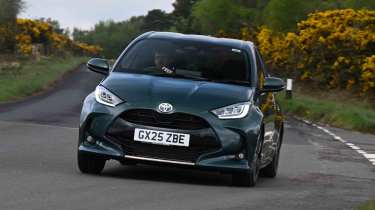
| Pros | Cons |
|
|
The Toyota Yaris is a competent all-rounder, offering a reasonable drive on a variety of roads. Its hybrid set-up is better suited to more measured inputs, and if you take that on board, you’ll be rewarded with a relaxing and smooth drive.
It’s quite a contrast to the far sportier Toyota GR Yaris, which may bear the same name but is a completely different beast underneath. The GR is basically a four-wheel-drive rally car that’s been tamed for the road, whereas the regular Yaris is an efficient front-wheel- drive runabout with a far simpler suspension arrangement of MacPherson struts at the front and a torsion beam at the rear.
Like its Honda Jazz and Renault Clio E-Tech rivals, the Yaris can drive on electric power alone for short periods of time during low-speed urban runs, although we’ve found you need to be really gentle with the accelerator to achieve this.
A key advantage of the Toyota hybrid system is that you don’t have to stop to plug in and recharge, or trail an extension cord to your car to top it up overnight. Instead, the Yaris’s battery pack is ‘refilled’ by a regenerative braking function, which produces electricity when you brake or coast. Excess power from the engine is used to charge the battery.
Performance, 0-60mph acceleration and top speed
The entry-level 114bhp hybrid system combined with a relatively low kerbweight of 1,085kg allows for a reasonably swift 0-62mph sprint of 9.7 seconds. It’s not a fast car with a top speed of 108mph, but that’s not a figure many Yaris customers will be actively trying to match. It’s not that kind of car.
The more potent electric motor with the 128bhp version means that you’re getting a little extra performance without dramatically increasing your running costs. In bald terms, the 0-62mph time is reduced to 9.2 seconds, making it slightly swifter than its Honda Jazz rival.
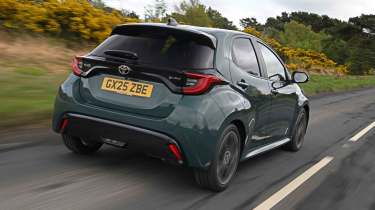
Town driving, visibility and parking
It’s around town where the Yaris shows off the best of its talents. Both the 114bhp and 128bhp versions feel similarly perky at low speeds, with plenty of initial shove provided almost instantaneously by the electric motor. That all helps make the Yaris feel easier to get away from the lights compared with a DSG automatic-equipped Skoda Fabia or VW Polo, where there’s a noticeable lag between putting your foot down and actually moving forward.
The steering feels precise, and the Yaris is easily manoeuvred around the tightest of turns, so parking up in narrow spaces should prove to be straightforward. Coupled with the diminutive exterior dimensions, the Yaris feels right at home in the urban environment. It's easy to brake to a smooth stop, and there’s plenty of stopping force should you need to quickly come to a halt for pedestrians.
You can avoid potholes and deep drain covers thanks to its nimble handling, and when you do encounter a speed bump, you won’t have your teeth shattered, because the ride is pleasingly compliant.
B-road driving and handling
Venture out of the urban hustle and you’ll quickly realise that the CVT transmission isn’t the most involving when pressing on through twisty B-roads – becoming quite noisy under hard acceleration due to the revs flaring as you build speed.
The handling is pretty agreeable, and the Yaris manages to avoid leaning over too much in bends if you start to press on. The ride can seem a little on the firm side given that you can detect some fidget over rougher surfaces at speed (which isn’t something that bothers the more refined Renault Clio), but the suspension deals with bigger bumps well enough and avoids feeling crashy.
Motorway driving and long-distance comfort
While you can use the Yaris for motorway drives, we find that the Clio is a more comfortable place to tackle a long jaunt. The engine in the Yaris can sound strained when getting up to speed, and there’s too much road noise, which is a shame because the car feels very stable at 70 mph, with well-controlled body movements over undulations that stop the ride from feeling bouncy.
The more potent 128bhp version is slightly easier to get up to motorway speeds, although doing so is still accompanied by plenty of the high-revving hysteria that you typically get with a continuously variable transmission (CVT). At least you don’t have to spend quite so long experiencing that din given that you get up to pace slightly more quickly.
Expert view, on driving experience
“The rear C-pillars are on the thick side, so over-the-shoulder vision is slightly impaired, but there’s a rear camera to help with reversing.” – Dean Gibson, Senior test editor, who tested a 1.5 Hybrid 116 Design against a Renault Clio E-Tech as part of a group test.
| Model | Power | 0-62mph | Top speed |
| Yaris 1.5 Hybrid Icon | 114bhp | 9.7 seconds | 108 mph |
| Yaris 1.5 Hybrid Excel | 128bhp | 9.2 seconds | 108 mph |
MPG & running costs
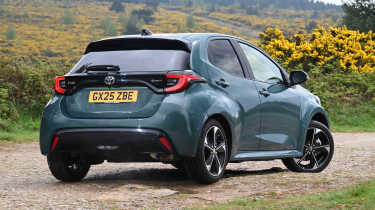
| Pros | Cons |
|
|
A supermini with a starting price of around £23,500 doesn’t sound like particularly great value, especially when the Yaris’ entry price is just over £1,500 more than the base-level Renault Clio E-Tech. The Yaris undercuts the Honda Jazz hybrid, though.
You will, however, save money at the petrol pump, because Toyota claims average fuel economy on the combined cycle of 68.9mpg. During our own testing, we saw an average of 65mpg, with the high economy figures unusually maintained through town centre driving. The 128bhp version uses a little more fuel at 67.3mpg, but we don’t think you’ll really notice such a small difference in the real world.
| Model | MPG | CO2 | Insurance group |
| Yaris 1.5 Hybrid Icon | 68.9mpg | 92g/km | 13 |
| Yaris 1.5 Hybrid Excel | 67.3mpg | 96g/km | 16 |
Insurance groups
No matter which trim level you opt for, the Yaris shouldn’t incur expensive insurance premiums. The entry-level 114bhp version in Icon trim sits in group 13, while the more powerful 128bhp model starts in group 15 in GR Sport trim. In comparison, the Honda Jazz starts from group 21.
Tax
No version of the Toyota Yaris (apart from the high-performance Toyota GR Yaris) costs more than £40,000, and so it avoids the additional luxury car tax surcharge. That means you’ll only need to pay the standard rate of vehicle excise duty (VED) from the second time the vehicle is taxed.
Low CO2 emissions ranging from 92g/km to 96g/km, depending on your chosen trim level, mean more affordable 24 and 25 per cent BiK (Benefit-in-Kind) tax rates, compared with the 26 per cent charge for the Honda Jazz.
Both are still a significant saving over a regular petrol supermini, such as the Skoda Fabia, but there are some fully-electric alternatives in the form of the MG4, Peugeot E-208, Renault 5 and Vauxhall Corsa Electric that have even lower company car tax costs.
Depreciation
According to our expert data, a fourth-generation Yaris should retain 48-54 per cent of its original value over a typical ownership period of three years or 36,000 miles. That’s on par with the Renault Clio, but the Honda Jazz does even better, maintaining between 54-57 per cent over the same period.
If you want a supermini that holds on to its value even better, go for the Audi A1 – in particular the 30 TFSI S Line, which maintains 59 per cent of its value.
Interior, design & technology
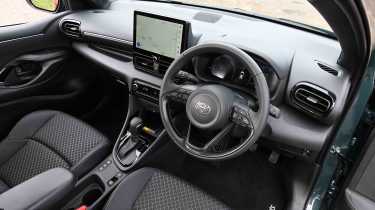
| Pros | Cons |
|
|
Toyota has bestowed the Yaris with a strong, distinctive look. The muscular wheelarches, large grille and sharp creases all contribute to a more purposeful stance than on the previous model, and an appearance that translates well to the beefed-up Toyota GR Yaris performance model.
There's a good level of standard equipment on offer. The entry-level Icon trim includes 16-inch alloy wheels, automatic headlights and wipers, adaptive cruise control, air conditioning, a reversing camera and a multi-function leather-trimmed steering wheel. It does have ‘keep fit’ manual rear windows in the back, so those with small children may want to go further up the range to get a model with electric rear windows you can lock to prevent them from being opened.
Stepping up to the Design versions adds bigger 17-inch wheels, rear privacy glass, electric rear windows and LED headlights. If you fancy a sportier look and can’t get your hands on the GR Yaris, the GR Sport features sporty styling touches inside and out (including 18-inch black alloys), sports suspension and keyless entry. The top-of-the-range Excel includes power folding mirrors, front and rear parking sensors, dual-zone climate control and some extra safety kit.
Interior and dashboard design
The dashboard looks solid and practical, but has very little sparkle or sense of style. However, we do approve of the simple-to-use climate controls that set it apart from touchscreen-based rivals like the Peugeot 208.
That doesn’t mean the Yaris is lacking in this digital age, because the base Icon and our preferred Design trim feature a nine-inch central touchscreen, while Excel and above use a larger 10.5-inch display. There are also three different instrument cluster designs, with Icon getting analogue dials, Design using a part analogue and part digital cluster, with Excel and GR Sport models gaining a fully customisable 12.3-inch screen.
Materials and build quality
We can’t deny that the inside of the Yaris is all well screwed together in the typical Toyota fashion, but it is a bit on the gloomy side thanks to lots of materials painted in black or dark grey. Some efforts have been made to cheer things up, with Icon and GR Sport trims using a few metal-effect accents, while Design and Excel employ glossy piano black trim in a bid to give the Yaris a more premium feel. Excel trim also introduces some leather strips and a diamond pattern design to the figure-hugging sports seats. The racier-looking GR Sport models feature aluminium pedals, a ‘GR Sport’ logo on the steering wheel and some red stitching on the seats.
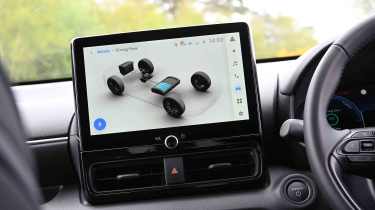
Infotainment, sat-nav and stereo
A 9.0-inch Toyota Touch 3 infotainment system comes as standard on entry-level Icon and mid-range Design, while Excel and GR Sport feature a 10.5-inch display with sat-nav included. Both touchscreens are positioned high on the dashboard. The smaller screen features some physical buttons on the passenger side of the screen, which is a little disappointing for a right-hand-drive car. The larger 10.5-inch screen has a volume dial in the middle below the screen, which is a much more sensible set-up.
Toyota’s standard 9.0-inch infotainment menu system isn’t quite as clear as we'd like, and there are a few too many sub-menus to navigate through if you want to change a setting – radio station selection is especially frustrating if you haven’t set up your favourites for instant access.
Despite being an upgraded system, the 10.5-inch set-up still isn’t as easy to navigate or as responsive to inputs as the one found in the Renault Clio, and it doesn’t have the French car’s Google-based sat-nav system, with up-to-the-minute traffic information or its intuitive voice recognition software, which helps with setting up route guidance because you can dictate where you want to go to the car.
Apple CarPlay and Android Auto smartphone connectivity is fitted as standard, so you can bypass Toyota’s system completely if you want. Wireless phone charging is standard on the Excel trim.
Expert view, on design
“While the fully configurable 12.3-inch digital display of Excel and GR Sport trims looks good and can show all sorts of information, it’s nowhere near as easy to navigate as what’s provided in a Skoda Fabia or VW Polo, with the Yaris requiring too many distracting long button presses to access certain menus.” – Max Adams, Online reviews editor, who tested a 1.5 Hybrid 130 Excel in Crawley, West Sussex.
Boot space & practicality
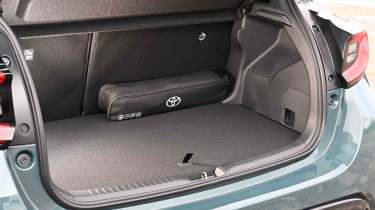
| Pros | Cons |
|
|
The Toyota Yaris comes as a five-door model only and offers solid practicality for urban drivers. There are plenty of storage spaces and cubby holes for assorted items, along with cupholders, useful seatback pockets and two rear coat hooks. The door bins are shallow and a little awkward to access due to the shape of the armrest above them, though.
The driving position and overall visibility are good, with the driver benefiting from a height-adjustable seat. Passenger seat height adjustment is fitted to the Excel trim. The steering wheel moves for reach and rake, helping to improve comfort over longer drives.
Toyota has provided other useful touches as standard – all Yaris versions include a central armrest, automatic headlights and wipers and power-adjustable heated door mirrors. The rear seats also split-fold in a 60:40 configuration, which helps improve storage space.
Brighter LED headlights come with the mid-range Design trim to aid night driving, and all models feature a reversing camera to help with parking. Front and rear parking sensors are an option on Design and GR Sport models, and come as standard on Excel.
Dimensions and size
The Yaris is slightly smaller than its predecessor, although Toyota has cleverly managed to increase the wheelbase by 50mm. Overall length is now 3,940mm, width 1,745mm and height 1,500mm. In comparison, the Honda Jazz is longer at 4,044mm, stands taller at 1,526mm, but its 1,694mm width makes it a little slimmer.
| Dimensions | |
| Length | 3,940mm |
| Width | 1,745mm |
| Height | 1,500mm |
| Number of seats | 5 seats |
| Boot space | 286-947 litres |
Driving position, seats & space in the front
There is enough space up front for a 5ft 10” driver, with sufficient headroom and legroom available. Taller people needing more kneeroom might want to consider rivals such as the Skoda Fabia, which is a bit more generous in that department.
The Icon and Design trims feature fairly flat front seats, whereas the Excel and GR Sport models have nicely bolstered sports seats that keep you in place during cornering. Both seat types are fine, but the seat base is a bit short for those with long legs, and there’s no ability to tilt the seat to improve the under-thigh support, so it might not be all that comfortable for longer trips. You do get electric lumbar adjustment in Excel trim, which is a rarity in this class.
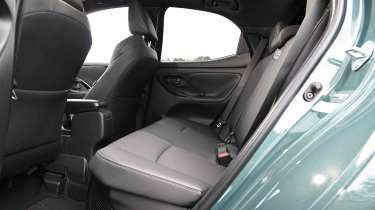
Seats & space in the back
Space in the back of the Yaris is at a premium. We found that a 5ft 10” adult sitting behind their preferred driving position will have their knees pressed into the seat in front, and their hair brushing the ceiling. Anyone taller would struggle further, and you’ll find it difficult to squeeze three across the back seat because the Yaris isn’t particularly wide. Two ISOFIX child seat mounting points are provided on the outer positions of the rear seats.
Boot space
Boot space for the Yaris stands at 286 litres, which is just about acceptable when judged against rivals. If you plan on carrying more luggage, you may want to take a closer look at some of the Yaris’ rivals: the Honda Jazz provides a decent 304 litres, or the more generous Skoda Fabia has a 380-litre capacity.
The Icon and Design trims don’t get an adjustable height boot floor, meaning there’s a sizable lip you need to lift heavier items over when loading up at the back. Higher Excel trims do get an adjustable height boot floor to reduce that gap, but this robs more space from an already small boot.
Folding the rear seats flat in the Yaris increases overall capacity to a reasonable 947 litres, but the Jazz is much more useful in this regard because its seats fold flat into the floor, and leave a larger 1,205 litre chasm.
Expert view, on practicality
“The rear door openings aren’t particularly wide, making access tricky if you’re trying to install a child seat or put a child in their car seat.” – Max Adams, Online reviews editor, who tested a 1.5 Hybrid 130 Excel in Crawley, West Sussex.
Reliability & safety
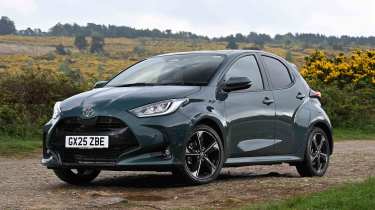
| Pros | Cons |
|
|
Toyota has long been known for producing reliable cars, with solid build quality and good levels of safety. In our 2024 Driver Power owner satisfaction survey, the Yaris finished in 3rd out of 50 on the best cars to own list, beating the VW Polo in 41st. Toyota placed 8th out of 32 manufacturers, which was behind Kia, but still well ahead of rivals such as Hyundai, Honda, Skoda, SEAT, VW, and Renault.
Safety expert Euro NCAP awarded the Yaris five stars for safety in 2020, with some impressive individual scores: adult and child occupant protection achieved 86 per cent and 81 per cent, respectively, while the car's onboard safety assist tech was given an 85 per cent rating. The Honda Jazz (tested in the same year) scored better in most areas, except for safety assistance technology.
The Yaris has lots of safety kit as standard, including active systems such as autonomous emergency braking (AEB), that’ll put the brakes on at lower speeds to hopefully avoid collisions with not just other cars, but cyclists, motor bikes, and pedestrians. It also has Emergency Steering Assist and lane keep assistance systems, helping to carefully nudge you back into your lane, and a Driver Attention Alert if the system thinks you need to stop and rest. Entry-level cars also come with a reversing camera, Automatic High Beam and Toyota’s e-call emergency call system to contact the emergency services if an airbag is deployed.
Like all modern cars, there’s a Road Sign Assist feature to ping up speed limit warnings, but that can be quite annoying if it displays the incorrect speed limit for the road you’re on, and unlike in the Clio – where there’s an easy way to switch it off – you have to spend a lot of time diving into sub-menus in the driver instrument cluster, which is highly distracting while driving.
High-end Excel trim comes with a blind spot monitoring system to let you know of vehicles alongside you on the motorway, and a rear-cross traffic alert system to warn you of vehicles crossing your path when reversing onto a main road.
| Key standard safety features | Euro NCAP safety ratings |
|
|
Buying and owning
- Best buy: Toyota Yaris 1.5 Hybrid 116 Design
While the 128bhp version is a good car in isolation, the extra cost over our preferred 114bhp version means it wouldn’t be the one we’d recommend. That also means you can stick with the well-specced and reasonably priced Design trim.
Toyota provides a standard three-year/60,000-mile warranty for the Yaris, which isn’t as long as some rivals. You can extend this for an extra 12 months/10,000 miles every time you have the car serviced up to a maximum of ten years/100,000 miles (whichever comes first), but the caveat is that servicing has to be completed by a Toyota franchised dealer in order to qualify for it.
Toyota says the fourth-generation Yaris needs servicing once a year or every 10,000 miles, whichever comes first. A smaller intermediate service costs £265, while a full service comes to £365. Alternatively, Yaris customers can take out a Toyota Service Plan from around £32 per month for a three-year plan, covering three services and the cost of an MoT – once the car is old enough to qualify for one. It also extends the one-year Toyota Roadside assistance policy every new Toyota car gets by two years.
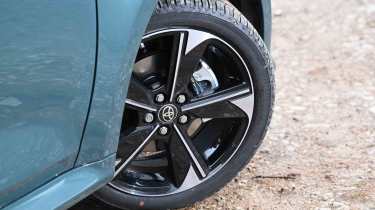
Alternatives
The Yaris is a fine small hybrid runabout, but it does cost an awful lot more than our favourite small car, the Renault Clio, which offers a hybrid system with similar performance and fuel economy figures to the Toyota, but a more refined driving experience and far greater practicality to boot.
In terms of practicality, no rival in this class does it better than the Honda Jazz. It may not be quite as efficient and it is costlier to buy, but it is stacked with versatile features, chief among them its innovative ‘Magic Seats’ that allow you to have a flat load area when they are folded down. Alternatively, you can pull the base up to create a separate load area from the boot to put a bike (possibly without the front wheel) across the width of the car.
Then there are a few all-electric alternatives that might take your fancy if you’re likely to spend more of your time in the urban jungle and you’ve got easy access to charging. For around the same money as a Yaris, the Renault 5 offers respectable practicality, zippy performance, and even greater refinement since there’s no petrol engine to cut in while accelerating. There’s also the even more affordable Citroen e-C3, which has a smooth ride and more space inside for four adults.
What do owners think?
Here’s what owners in the 2024 Driver Power survey thought of the Toyota Yaris.
| What they like | What they don't like |
| “It’s smooth and responsive. When you need a little bit of extra power, the car is more than willing to respond.” | “The driver’s seat needs a bit more height adjustment. I’m quite small and I struggle to see where the nose is.” |
| “Our Yaris is excellent in terms of cabin quality. It feels very much like the BMW we previously owned.” | “When the doors are closed with any force at all, they feel and sound as though they’re very cheaply made.” |
| “I have been buying Toyota for 30 years and I think the design and materials get better and better.” | “The infotainment is awful. It should be so much better, or easier to upgrade to an aftermarket system.” |
| “The infotainment sounds great, plus it’s easy and convenient to use, with clearly laid-out controls.” | “The boot is tiny compared with similar models from other brands. The sloping hatch makes things worse.” |
| “Excellent car. Very comfy and lovely to drive, with responsive acceleration and very reassuring brakes.” | “The quality of the interior trim is poor and rather shocking for an almost-£25,000 car.” |
| “My Yaris is the best car that I’ve ever bought. The interior quality and exterior design are both fantastic.” | |
| “I love driving my Yaris because it requires very little effort. It’s responsive, smooth and very comfortable, which makes every journey a breeze, no matter how far.” | |
| “There is plenty of room with the back seats down, and the front seats adjust to suit me perfectly as a taller chap. I do lots of very long journeys into Europe and it never gets tiring.” | |
| “The Yaris is small, so I don’t expect a big boot, but the size is ample for my needs and there’s room for a spare wheel underneath. I have grandchildren and I can just about get a buggy in the boot; it’s the reason why I moved up from my previous Aygo.” |
Tell us what you think of your car! Take the Driver Power survey…
Toyota Yaris pictures
Frequently Asked Questions
The Toyota Yaris is very safe, well-equipped, and highly economical. However, there are better family-oriented superminis offering more passenger space, and the Yaris isn’t a barrel of laughs to drive. That honour is reserved for the (impossible to order) GR Yaris hot hatch.

